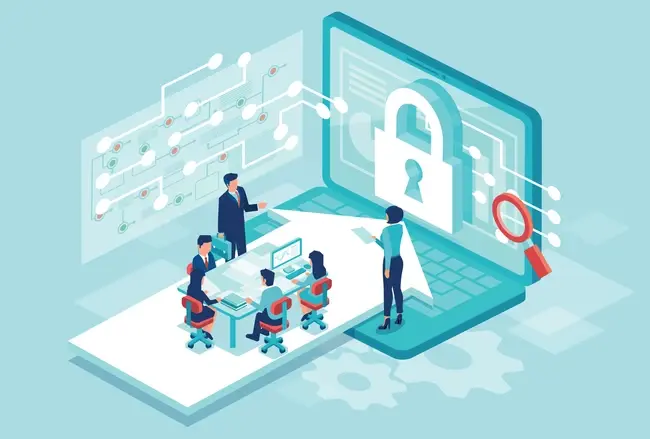This article was contributed by Devin Partida, who writes about technology and business solutions. To read more from Devin, you can also find her over at ReHack.com, where she is Editor-in-Chief.

Even when business leaders and IT managers think they have a handle on office security threats, they may initially forget to address some. Here are four of them.
1. Mobile Device Security
More people are getting work done on mobile devices. Relatedly, a growing number of those employees bring personal gadgets to the workplace. In a 2020 survey, 55% of IT department employees reported that their organizations allow the use of personal mobile devices at work. Then, approximately 45% of the employees polled in the research said they depend on gadgets brought from home at work.
However, 62% of the IT professionals who responded to the study reported that their workplaces did not take the necessary steps to protect company information stored on mobile phones. Additionally, of the people using personal mobile devices to access work-related content, 56% did not use two-factor authentication when doing so.
Business leaders cannot count on employees using best practices when depending on their mobile devices at work. The better method is to take a multipronged approach to device security.
For example, only allow employees to connect devices to networks after IT leaders assess them and fix any vulnerabilities. Intelligent monitoring tools could also bolster visibility by helping organizational leaders understand when and where employees use their mobile devices for work reasons.
2. Inconsistent Security Training
Cybersecurity threats constantly evolve as criminals try to stay ahead of the IT practitioners that aim to thwart their tactics. Unfortunately, employees rarely get ongoing training to help them recognize and prepare for the newest dangers. Some workers only receive such education once, while others don’t even have that opportunity.
Research published in 2018 found that 65% of companies reported not providing employee cybersecurity training about best practices. Larger businesses were more likely to include that content in their employee education plans than smaller ones.
A 2020 poll illuminated the need for substantial improvement. For example, 39% of employees believed that merely leaving a computer unlocked could cause a malware infection. Further, one in seven thought a computer with a virus could transmit it rapidly to the nearest machines, much like humans spread illnesses.
More than a quarter of respondents had trouble identifying the signs of a phishing email, which suggests they need additional information to help lead the fight against such attacks.
3. Connected Office Equipment
Printers and fax machines are modern office staples. Many people are now so accustomed to using them daily that the associated security risks never cross their minds. A survey of IT decision-makers in the United States found that only 38% prioritized document security for their businesses.
They overlook the fact that today’s technology connects to the internet and has internal hard drives like computers. Likewise, networked office equipment becomes vulnerable to hacking if company decision-makers do not become aware of problems and fix them immediately.
However, when business leaders think of the volumes of valuable and often confidential information this equipment handles, many will likely start emphasizing this aspect of security for their companies. Straightforward choices like ensuring that printers have the latest firmware installed can go a long way in minimizing attacks.
4. Third-Party Vendors
Efforts to keep an office secure span beyond a company’s walls. They also extend to any third-party vendors or other partners an organization relies upon to get needs met. That’s why IT professionals should thoroughly vet any outside companies before finalizing a decision to share data with them.
Data breaches associated with third-party vendors can be significant events. A single incident in November 2020 affected more than 27 million drivers in Texas. Things went wrong when a Colorado software company that provides products for insurance carriers stored files in an unsecured external storage service.
Unauthorized access to the data led to compromised details, including names, addresses, dates of birth and vehicle registration histories.
Business IT professionals must understand and classify the risks connected to third-party vendors. They should also determine whether a company implements features like data encryption to boost security. If an assessment reveals that a vendor falls short, that’s a valid reason to reconsider working with them or insist that they improve for the relationship to continue.
Awareness Facilitates Enhanced Security
Even the most dedicated company leaders cannot take the crucial steps to fix problems they never considered. The examples here should give people food for thought and lead them to conclude that there are likely some gaps in office security to close as soon as possible.
Those realizations can feel discouraging at first. However, people should reshape their mental frameworks and understand that knowing that a problem exists is the first essential ingredient to thoroughly tackling it.
As people become more aware of previously unmanaged office security risks, they’ll make gradual, but meaningful, progress toward having safer organizations.







Comments ( 0 )